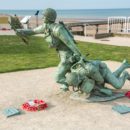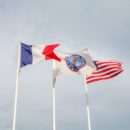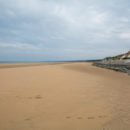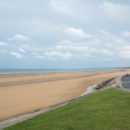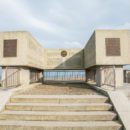Our last stop on the Normandy Tour was Omaha Beach. We were fortunate to be there at low tide so we could walk on the beach and look up at something similar to what the Allied troops had seen many years prior. The odds here weren’t good and the battle was unevenly matched heavily favoring the Germans on land vs. the Allies at sea.
Omaha Beach was the code name for one of the five sectors of the Allied invasion of German-occupied France in the Normandy landings on 6 June 1944, during World War II. Omaha is on the coast of Normandy, France, facing the English Channel, and is 8 kilometers (5 mi) long, from east of Sainte-Honorine-des-Pertes to west of Vierville-sur-Mer on the right bank of the Douve River estuary. Landings here were necessary to link the British landings to the east at Gold with the American landing to the west at Utah, thus providing a continuous lodgement on the Normandy coast of the Bay of the Seine. Taking Omaha was to be the responsibility of United States Army troops, with sea transport, minesweeping, and a naval bombardment force provided predominantly by the United States Navy and Coast Guard, with contributions from the British, Canadian, and Free French navies.
On D-Day, the untested 29th Infantry Division, along with nine companies of U.S. Army Rangers redirected from Pointe du Hoc, were to assault the western half of the beach. The battle-hardened 1st Infantry Division was given the eastern half. The initial assault waves, consisting of tanks, infantry, and combat engineer forces, were carefully planned to reduce the coastal defenses and allow the larger ships of the follow-up waves to land.
The primary objective at Omaha was to secure a beachhead of eight kilometres (5 miles) depth, between Port-en-Bessin and the Vire River, linking with the British landings at Gold to the east, and reaching the area of Isigny to the west to link up with VII Corps landing at Utah. Opposing the landings was the German 352nd Infantry Division. Of the 12,020 men of the division, 6,800 were experienced combat troops, detailed to defend a 53-kilometer (33 mi) front. The Germans were largely deployed in strongpoints along the coast—the German strategy was based on defeating any seaborne assault at the waterline.
Very little went as planned during the landing at Omaha. Difficulties in navigation caused the majority of landing craft to miss their targets throughout the day. The defenses were unexpectedly strong, and inflicted heavy casualties on landing U.S. troops. Under heavy fire, the engineers struggled to clear the beach obstacles; later landings bunched up around the few channels that were cleared. Weakened by the casualties taken just in landing, the surviving assault troops could not clear the heavily defended exits off the beach. This caused further problems and consequent delays for later landings. Small penetrations were eventually achieved by groups of survivors making improvised assaults, scaling the bluffs between the most heavily defended points. By the end of the day, two small isolated footholds had been won, which were subsequently exploited against weaker defenses further inland, thus achieving the original D-Day objectives over the following days. [SOURCE]
The area was beautiful and given the two original buildings we saw on the tour very close to what it must have looked like prior to WWII. It was quiet and the other than a couple of tours and few people at the memorial almost completely empty.


